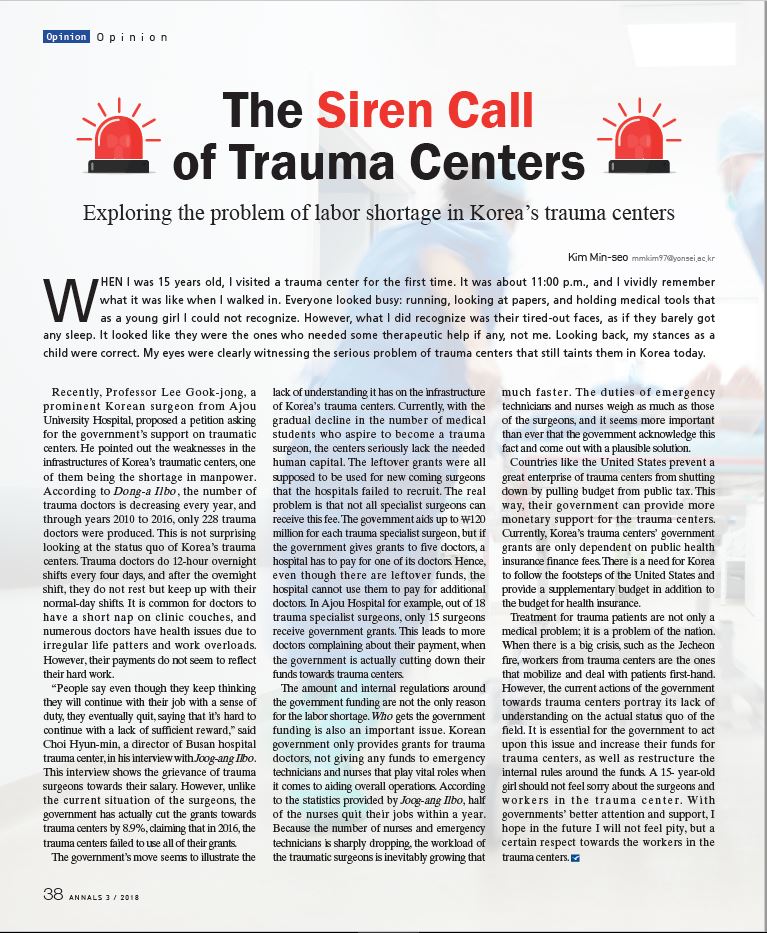Exploring the problem of labor shortage in Korea’s trauma centers

WHEN I was 15 years old, I visited a trauma center for the first time. It was about 11:00 p.m., and I vividly remember what it was like when I walked in. Everyone looked busy: running, looking at papers, and holding medical tools that as a young girl I could not recognize. However, what I did recognize was their tired-out faces, as if they barely got any sleep. It looked like they were the ones who needed some therapeutic help if any, not me. Looking back, my stances as a child were correct. My eyes were clearly witnessing the serious problem of trauma centers that still taints them in Korea today.
Recently, Professor Lee Gook-jong, a prominent Korean surgeon from Ajou University Hospital who gained media attention for saving a North Korean soldier’s life, proposed a petition asking for the government’s support on traumatic centers. He pointed out the weaknesses in the infrastructures of Korea’s traumatic centers, one of them being the shortage in manpower. According to Dong-a Ilbo, the number of trauma doctors is decreasing every year, and through years 2010 to 2016, only 228 trauma doctors were produced. This is not surprising looking at the status quo of Korea’s trauma centers. Trauma doctors do 12-hour overnight shifts every four days, and after the overnight shift, they do not rest but keep up with their normal-day shifts. It is common for doctors to have a short nap on clinic couches, and numerous doctors have health issues due to irregular life patters and work overloads. However, their payments do not seem to reflect their hard work.
“People say even though they keep thinking they will continue with their job with a sense of duty, they eventually quit, saying that it’s hard to continue with a lack of sufficient reward,” said Choi Hyun-min, a director of Busan hospital trauma center, in his interview with Joong-ang Ilbo. This interview shows the grievance of trauma surgeons towards their salary. However, unlike the current situation of the surgeons, the government has actually cut the grants towards trauma centers by 8.9%, claiming that in 2016, the trauma centers failed to use all of their grants.
The government’s move seems to illustrate the lack of understanding it has on the infrastructure of Korea’s trauma centers. Currently, with the gradual decline in the number of medical students who aspire to become a trauma surgeon, the centers seriously lack the needed human capital. The leftover grants were all supposed to be used for new coming surgeons that the hospitals failed to recruit. The real problem is that not all specialist surgeons can receive this fee. The government aids up to 120 million for each trauma specialist surgeon, but if the government gives grants to five doctors, a hospital has to pay for one of its doctors. Hence, even though there are leftover funds, the hospital cannot use them to pay for additional doctors. In Ajou Hospital for example, out of 18 trauma specialist surgeons, only 15 surgeons receive government grants. This leads to more doctors complaining about their payment, when the government is actually cutting down their funds towards trauma centers.
The amount and internal regulations around the government funding are not the only reason for the labor shortage. Who gets the government funding is also an important issue. Korean government only provides grants for trauma doctors, not giving any funds to emergency technicians and nurses that play vital roles when it comes to aiding overall operations. According to the statistics provided by Joong-ang Ilbo, half of the nurses quit their jobs within a year. Because the number of nurses and emergency technicians is sharply dropping, the workload of the traumatic surgeons is inevitably growing that much faster. The duties of emergency technicians and nurses weigh as much as those of the surgeons and it seems more important than ever that the government acknowledge this fact and come out with a plausible solution.
Countries like the United States prevent a great enterprise of trauma centers from shutting down by pulling budget from public tax. This way, their government can provide more monetary support for the trauma centers. Currently, Korea’s trauma centers’ government grants are only dependent on public health insurance finance fees. There is a need for Korea to follow the footsteps of the United States and provide a supplementary budget in addition to the budget for health insurance.
Treatment for trauma patients are not only a medical problem; it is a problem of the nation. When there is a big crisis, such as the Jaecheon fire, workers from trauma centers are the ones that mobilize and deal with patients first-hand. However, the current actions of the government towards trauma centers portray its lack of understanding on the actual status quo of the field. It is essential for the government to act upon this issue and increase their funds for trauma centers, as well as restructure the internal rules around the funds. A 15- year-old girl should not feel sorry about the surgeons and workers in the trauma center. With governments’ better attention and support, I hope in the future I will not feel pity, but a certain respect towards the workers in the trauma centers.
Kim Min-seo
mmkim97@yonsei.ac.kr

